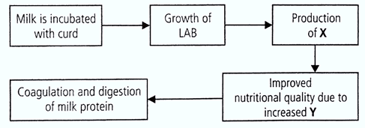MEDIUM
Earn 100
Identify the missing parts and from the following flow chart depicting the formation of curd from milk.


(a) Gluconic acid, Vitamin
(b) Lactic acid, Vitamin
(c) Lactic acid, Vitamin
(d) Citric acid, Vitamin
50% studentsanswered this correctly
Important Questions on Microbes in Human Welfare
EASY
HARD
HARD
An example of microbe in human welfare is given. Classify it under the headings given below:
Some examples of microbes in human welfare are given. Classify them under the headings given below:
[Egs : Rhizobium, Propionibacterium sharmanii, Azospirillum, Lactic acid bacteria, Anabaena, Azotobacter, Aspergillus niger, Saccharomyces cerevisiae]
| Microbes in household | Microbe as Biofertilisers |
EASY
Role of microbes in household food processing.
EASY
HARD
EASY
HARD
HARD
| Column I | Column II | ||
| A | Lactobacillus | (i) | Production of genetically-engineered clot busters |
| B | Monascus purpureus | (ii) | Production of citric acid |
| C | Streptococcus | (iii) | Conversion of milk into curd |
| D | Aspergillus niger | (iv) | Production of blood-cholesterol lowering agents |
EASY
MEDIUM
EASY
MEDIUM
Microbes are useful to human beings in diverse ways. If so, name the following:
Lactic acid-producing bacterium
EASY
MEDIUM
EASY
HARD
MEDIUM
MEDIUM
MEDIUM
| Column - I | Column – II | ||
|---|---|---|---|
| Clostridium butylicum | Lactic acid | ||
| Saccharomyces cerevisiae | Butyric acid | ||
| Aspergillus niger | Citric acid | ||
| Acetobacter aceti | Alcohol | ||
| Acetic acid |

